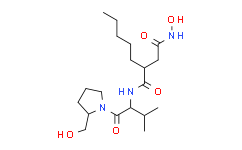Actinonin inhibits cell growth in various human tumor cell lines. The IC50 of 4, 6.9, 12.8, 16.6, 27.4, 15.7 and 49.3 μM for Raji cells, MDA-MB-468 cells,PC3 cells, SK-LC-19 cells, Hela cells, HT-1080 cells and AL67 cells, respectively.
HsPDF is a critical target of actinonin and that the inhibition of this protein in the mitochondria leads to cell death in tumor cells. Actinonin treatment of cells led to a tumor-specific mitochondrial membrane depolarization and ATP depletion in a time- and dose-dependent manner.
Actinonin is a potent inhibitor of all three forms (Zn-, Ni-, and Fe-) of peptide deformylases from both S. aureus and E. coli bacteria. Under the assay conditions, the IC50 values for Actinonin are 90, 3, 0.8, and 11 nM for Zn-PDF (E. coli), Ni-PDF (E. coli), Fe-PDF (E. coli), and Ni-PDF (S. aureus), respectively.
Actinonin is active against Gram-positive bacteria, including S. aureus (MIC value of 8-16 μg/mL), Streptococcus pyogenes (MIC value of 8 μg/mL) and Streptococcus epidermidis (MIC value of 2-4 μg/mL). Actinonin is also active against fastidious Gramne-gative bacteria, such as H. influenzae (MIC value of 1-2 μg/mL), Moraxella catarrhalis (MIC value of 0.5 μg/mL), and Neisseria gonorrheae (MIC value of 1-4 μg/mL). Actinonin is very active against the H. influenzae acr (MIC value of 0.13 μg/mL) and E. coli acr (MIC value of 0.25 μg/mL) efflux pump mutants.
Medlife has not independently confirmed the accuracy of these methods. They are for reference only.



 扫码关注公众号
扫码关注公众号